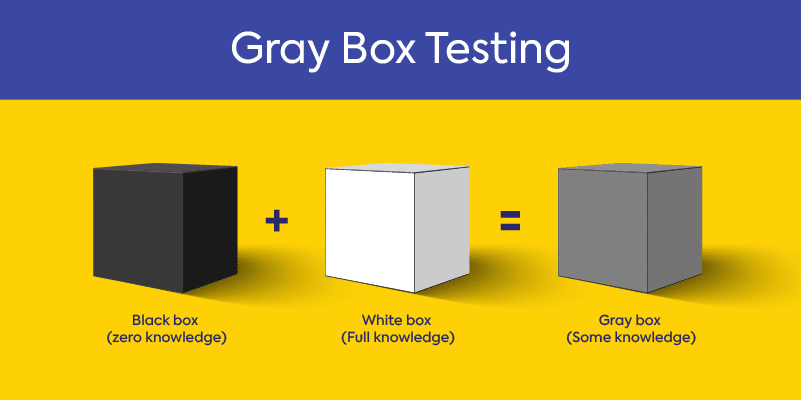Gray Box Testing Guide


In order to develop stable and secure applications, you need to inspect and verify that your software performs as expected. The most common approaches to testing software are white box testing, black box testing, and gray box testing. While white box testing and black box testing have their pros and cons, gray box testing combines the two testing approaches in an attempt to overcome their deficits.
Gray box testing, also spelled as grey box testing, aims to rectify the loopholes and inefficiencies found in white box and black box testing. It has been developed to be a productive mix of the two testing techniques.
This blog walks through the gray box testing method and covers the following subjects:
What Is Gray Box Testing?
Gray box testing is a blend of black box and white box testing. In black box testing, the internal working structure of the application is unknown. In white box testing, the internal working structure is known.
With gray box testing, the tester partially understands the application’s internal working structure. Testing is undertaken based on the limited knowledge of the underlying code and architecture of the application. The term “gray box” is used because, in the eyes of software testers, the application is like a semi-transparent (gray) box through which they can partially see into its inner workings.
Gray box testing is a good way of finding security flaws in programs. It can assist in discovering bugs or exploits due to incorrect code structure or incorrect use of applications.
By combining white box and black box testing, gray box testing tries to get the best out of the two techniques. A gray box tester takes the code-targeted approach of white box testing and merges it with the various approaches of black box testing like functional testing and regression testing. The tester assesses both the software’s internal workings and its user interface.

Gray Box Testing Example
Let’s use a simple example of a hyperlink on a webpage to understand how gray box testing works and how it differs from the other types of software testing.
In gray box testing, the tester may start by clicking the hyperlink to check whether it opens a new page. The tester would then check if the HTML code is pointing to the correct URL using the correct syntax. Finally, the tester rechecks the user interface to confirm that the browser redirects them to the correct URL.
If the tester were performing white box testing, they would only check if the HTML is coded properly and it points to the correct URL using the correct syntax. In black box testing, they would only click the hyperlink and check if the browser redirects them to a new URL.
How Is Gray Box Testing Performed?
In gray box testing, test cases are designed based on the knowledge of the application’s architecture or understanding of its behavior. It may not be necessary to access all the source code; functional specifications and other software design materials can be used.
These are the steps you follow to carry out gray box testing:
- Identify testing inputs from both white box and black box testing inputs.
- Identify the expected outputs from these selected inputs.
- Identify all key paths to traverse through during the testing process.
- Identify the sub-functions, which are part of the main testing functions, for undertaking deep level testing.
- Identify the inputs for the selected sub-functions.
- Identify the expected outputs for the sub-functions.
- Execute a test case for the sub-functions.
- Assess and verify the correctness of the test result.
- Repeat steps 4 to 8 for the remaining sub-functions.
- Repeat steps 7 and 8 for the remaining sub-functions.
Gray Box Testing Techniques
The main techniques for performing gray box testing include matrix testing, regression testing, pattern testing, and orthogonal array testing.
Matrix Testing
Matrix testing entails testing all the variables existing in an application. Variables are an important aspect of any software because they act as the elements for transporting values throughout the software. In matrix testing, the inherent business and technical risks associated with every variable are defined. Every variable is then examined based on the risks it comes with. It’s a good technique for discovering unused or un-optimized variables in the program.
Regression Testing
Regression testing requires performing repeated gray box tests to verify that previously created and tested software still works as desired after every modification or update.
Pattern Testing
Pattern testing involves analyzing the previous version of the software in order to discover patterns that cause defects. This assessment may point out the factors that contributed to the defects, how the anomalies were discovered, and whether the fixes were beneficial. This information can then be used to improve the design of gray box test cases, which can assist in averting similar problems in new versions of the software or new software developed using similar structures.
Orthogonal Array Testing
Orthogonal array testing is an organized, statistical method of performing tests. It’s often used when the number of inputs to the software is relatively small, but too large to carry out exhaustive testing. This technique allows for maximum code coverage while using minimal test cases, especially when testing complex applications.
Gray Box Testing Tools
Here are some popular open source tools for carrying out gray box testing:
- Selenium consists of a suite of software testing tools for writing automated tests that validate web applications across a wide range of environments. It supports several programming languages, such as JavaScript, Java, and Python.
- JUnit is a unit testing tool for the Java programming language. It’s helpful for writing and executing repeated tests.
- Appium is a test automation tool for mobile-web applications, native applications, and hybrid applications. It can be run on iOS, Android, or Windows using a webdriver.
- Cucumber is used to create automated test cases that assess the behavior of software.
Gray Box Testing Advantages
Gray box testing has several key advantages. Testing is done from both the user and developer’s point of view, which improves its effectiveness. It combines the benefits of black box testing and white box testing, enhancing the overall quality of the released software. Gray box testing is unbiased and non-intrusive. This prevents disagreements between developers and testers. Finally, the partial understanding of the application’s internal mechanisms can help testers design better test cases.
Gray Box Testing Disadvantages
Gray box testing does have several disadvantages. Since testers have limited access to the application’s internal working, it may be difficult to achieve full code path coverage, which could cause testers to miss some critical flaws. Tests may be redundant, especially if the developer has already performed similar tests. In addition, running tests on every potential input stream is too demanding and may cause some application paths to not be tested.
Gray Box Testing: An Essential Part of Software Testing
In software testing, gray box testing is a powerful technique for ensuring the shipped software is performant, secure, and meets the needs of the intended users. It offers an effective approach to test applications externally, while taking note of their internal working structure.
Of course, you may decide to use either white box testing or black box testing exclusively in some situations. For example, if you want to perform deep and thorough tests, based on the application’s source code, you may go for white box testing. On the other hand, if you want to run tests from the perspective of a non-informed outside user, black box testing may better suit your needs.
